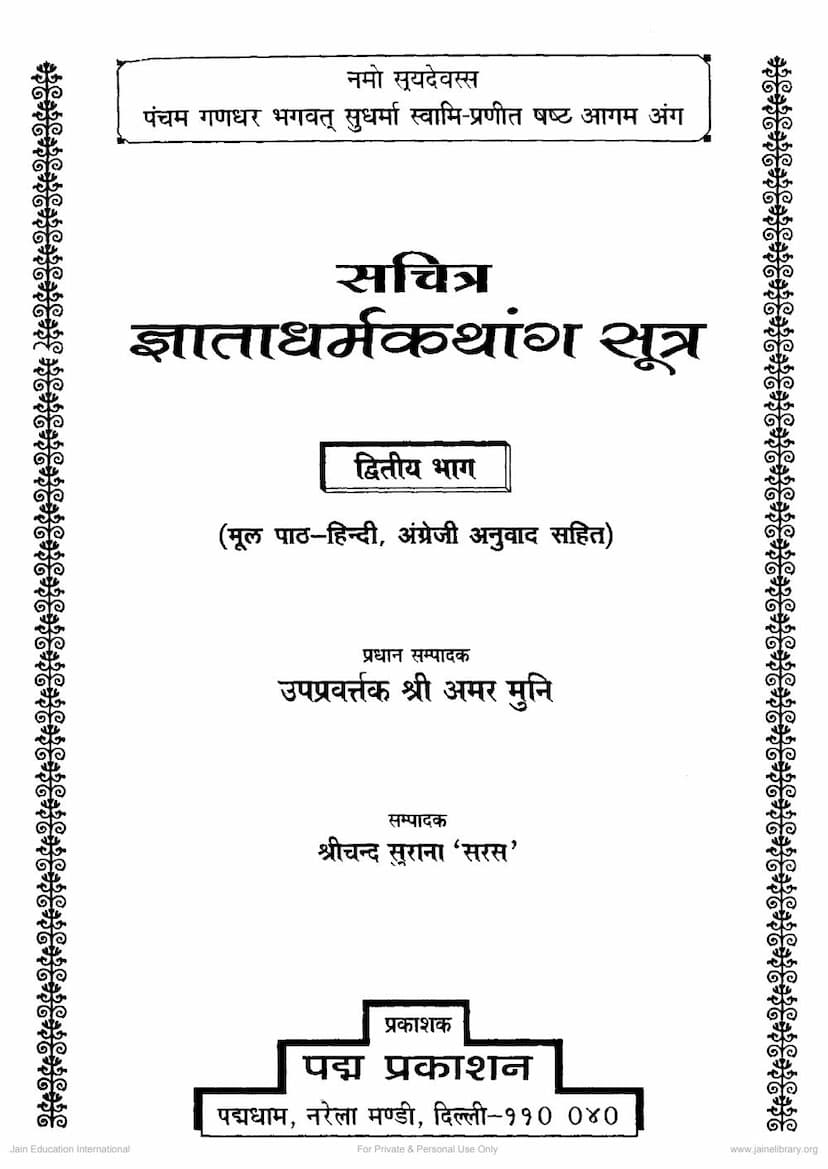Agam 06 Ang 06 Gnatadharma Sutra Part 02 Sthanakvasi
Added to library: September 1, 2025

Summary
This detailed summary provides an overview of the Jain text "Agam 06 Ang 06 Gnatadharma Sutra Part 02 Sthanakvasi," authored by Amarmuni, Shreechand Surana, Surendra Bothra, and Purushottamsingh Sardar, and published by Padma Prakashan. The catalog link provided is jainqq.org/explore/007651/1.
The text is the second part of the Illustrated Gnatadharma Kathanga Sutra, dedicated to the sixty-fourth anniversary of the initiation ceremony of Gurudev Bhandari Shri Padmachandra ji Maharaj.
Key aspects and themes highlighted in the provided pages include:
- The Importance of Shastras (Religious Texts): The publishers emphasize that Shastras are not mere books but guidebooks for life, acting as a "third eye" or the conscience of humans, helping to rule over life and the mind. They inspire the study of Shastras for achieving a balanced life and understanding the true nature of existence.
- The Gnatadharma Kathanga Sutra: This is described as the sixth Agamanga and the fifth Ganadhara, Bhagavat Sudharma Swami. It is recognized as the most famous, interesting, and largest scripture in the Dharma Kathanuyog (category of religious stories). Its stories are considered to have parallels in Buddhist, Vedic, and foreign literature, indicating their universal appeal and influence.
- The Nature of Wisdom: True wisdom is defined as balanced knowledge of life and the world, a correct understanding of the soul, the divine, the living and non-living, spirituality, and science, and the ability to live a balanced life and guide others.
- The Role of Illustrations: The publication includes illustrations to make even complex subjects simple and easy for readers to comprehend, encouraging the study of these texts.
- The Publishers' Mission: Padma Prakashan, under the inspiration of Gurudev Shri Padmachandra ji Maharaj and Up-pravartak Shri Amar Muni ji Maharaj, aims to make religious texts accessible to every household and promote their study. The project includes the illustrated publication of Agam literature, with several works already released and this being the second part of the Gnatadharma Kathanga Sutra.
- Dedication and Support: The publication is dedicated to the sixty-fourth anniversary of Gurudev Shri Padmachandra ji Maharaj's initiation. The project is supported by the generous contributions of devotees and the inspiration of scholarly Shramanas.
- Editorial Approach: The editing style aims for comprehensiveness, with explanations of chapter titles, synopses of stories, and a focus on providing all relevant material within each chapter to avoid readers having to constantly flip pages.
- The Content of the Sutra: The text covers nineteen chapters in the first part and the remaining in the second part. The summaries of the chapters provided (Ninth to Nineteenth) reveal a rich tapestry of stories, moral lessons, and philosophical insights.
Specific Chapters and Their Themes (as indicated in the table of contents and summaries):
- Ninth Chapter: Makandi: Explains the virtues and vices of attachment and detachment to sensual pleasures through the story of the two sons of a merchant. It highlights the contrast between those who remain steadfast and those who succumb to temptations.
- Tenth Chapter: The Moon: Uses the moon's waxing and waning as an analogy to explain the growth and decline of spiritual virtues in ascetics, emphasizing the importance of continuous effort and avoiding laxity.
- Eleventh Chapter: The Davadrav: Uses the Davadrav tree's sensitivity to winds as an example to explain the concept of tolerance and equanimity for ascetics, categorizing them into partial decliners, partial aspirers, absolute decliners, and absolute aspirers based on their ability to withstand criticism.
- Twelfth Chapter: The Water: Illustrates the nature of transformation and the importance of understanding things beyond their superficial appearance, using the example of purifying dirty water to make it potable and pleasant. It teaches about detachment from worldly desires and the power of right conduct.
- Thirteenth Chapter: The Frog: Demonstrates the dire consequences of attachment to worldly comforts, using the story of a merchant's son who is reborn as a frog due to his infatuation with a pond he built. It shows how self-reflection and true devotion can lead to liberation.
- Fourteenth Chapter: Tetaliputra: Explores the theme of how external influences and hardships can lead to spiritual awakening, using the story of minister Tetaliputra and his journey from worldly attachment to renunciation and enlightenment after facing severe trials.
- Fifteenth Chapter: The Nandi-Fruit: Warns against the allurements of sensual pleasures, using the example of the toxic Nandi trees whose attractive fruits lead to death if consumed. It highlights the importance of discernment and avoiding what is forbidden for spiritual progress.
- Sixteenth Chapter: Amarkanka: A lengthy and complex narrative involving abduction, betrayal, suffering, and eventual liberation. It illustrates the consequences of vices like pride and lust, the importance of spiritual discipline, and the role of divine intervention in certain situations. It also features the epic story of Draupadi and her multifaceted life.
- Seventeenth Chapter: Akeerna (Horses): Uses the example of horses being trapped or remaining free based on their reaction to alluring external factors to explain the consequences of attachment versus detachment from sensual pleasures. It emphasizes the importance of controlled desires and spiritual awareness.
- Eighteenth Chapter: Sumsuma: Focuses on the severe consequences of evil deeds, the depravity that can arise from unchecked vices, and the ultimate sacrifice one might make for spiritual redemption. The story of Chilat and Sumsuma highlights the karmic retribution for wickedness and the potential for spiritual progress even through extreme measures.
- Nineteenth Chapter: Pundareek: Illustrates the futility of external spiritual practices without inner sincerity and the value of true inner transformation, using the stories of Pundareek and Kandareek to contrast spiritual dedication with worldly attachment.
Overall Goal: The publication and the Gnatadharma Sutra itself aim to provide profound spiritual knowledge, moral guidance, and inspiration through captivating narratives and examples, making the teachings of Lord Mahavir accessible and understandable to a wider audience.